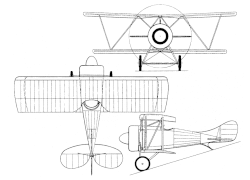Adamoli-Cattani fighter
The Adamoli-Cattani fighter was a prototype fighter aircraft designed as a private venture by two Italian aircraft builders in 1918.
| Adamoli-Cattani fighter | |
|---|---|
| Role | Fighter |
| National origin | Italy |
| Manufacturer | Farina and Officine MoncenisioEwed |
| Designer | Signori Adamoli & Cattani[1] |
| First flight | 1918 |
| Number built | 1[1] |
Design and development
The Adamoli-Cattani was intended to be the smallest practical biplane around the most powerful engine available to them, a 149 kW (200 hp) le Rhône M. The result was a reasonably conventional design, other than that the wings featured hinged leading edges in place of conventional ailerons. The Farina Coach Building factory in Turin began construction of the prototype; the Officine Moncenisio in Condove completed it.[1]
Operational history
Upon completion, ground testing revealed that the engine as installed could only deliver some 80% of its rated power, thus leaving the aircraft significantly underpowered. Limited tests continued until the end of World War I, when the Armistice made further development superfluous.[1]
Specifications (estimated performance with 200hp engine)

Data from The Complete Book of Fighters[1]
General characteristics
- Crew: 1
- Length: 6.10 m (20 ft 0 in)
- Wingspan: 8.60 m (28 ft 3 in)
- Empty weight: 470 kg (1,036 lb)
- Gross weight: 675 kg (1,488 lb)
- Powerplant: 1 × le Rhône M 9-cyl. air-cooled rotary piston engine, 150 kW (200 hp) (rating) - actual power 119 kW (160 hp)
Performance
- Maximum speed: 186 km/h (116 mph, 100 kn)
- Endurance: 2.25
Armament
- Guns: 2 x .303-in (7.7-mm) machine guns
References
- Green, William; Gordon Swanborough (1997). The Complete Book of Fighters. London: Salamander Books Limited. p. 8. ISBN 1-85833-777-1.